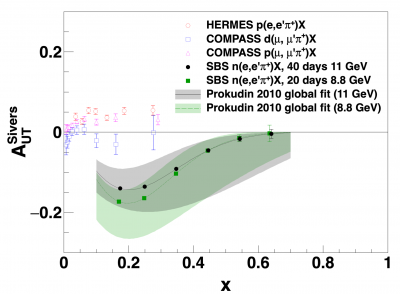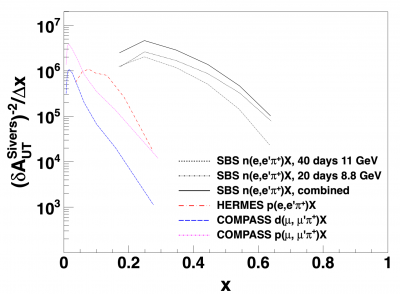Experiment E12-09-018 (the SBS SIDIS experiment) in Jefferson Lab’s Hall A, first approved by JLab PAC38 for 64 beam-days with an “A-” scientific rating in 2011, was evaluated under the Jefferson Lab Program Advisory Committee’s jeopardy process, which periodically reconsiders the approval status, beam time allocation, and scientific rating of experiments which have been approved but not yet scheduled after a certain amount of time. The experiment is currently expected to run some time in 2023. PAC49, held during July 19-23, considered the continued science motivation for the experiment and reviewed the progress in the preparation of the experiment since it was first approved, and re-approved it with no change in beam time allocation or scientific rating.
- Jeopardy proposal (re-approved July, 2021)
- PAC38 proposal (approved August, 2011)
The experiment will measure so-called “single-spin asymmetries” (SSAs) in the production of charged and neutral pions and kaons in “deep inelastic” collisions of CEBAF’s continuous electron beam with transversely polarized neutrons in Helium-3 nuclei (transversely polarized means that the spin-1/2 Helium-3 nuclei, and therefore the unpaired neutrons they contain, have their nuclear spins preferentially aligned perpendicular to the direction of the electron beam). These asymmetries are sensitive to the orbital motion and transverse polarization of the neutron’s elementary quark constituents, and can provide for three-dimensional “imaging” of quarks’ motion and spin inside the neutron. The kinematics of the collisions, known as “Semi-Inclusive Deep Inelastic Scattering (SIDIS)” are chosen such that the cross section for the observed reaction is dominated by hard scattering of electrons by quasi-free quarks in the target neutron, and independent “fragmentation” of the recoiling quarks into observable hadrons (pions, kaons, etc).
By using the BigBite and Super BigBite spectrometers in Jefferson Lab’s experimental Hall A, together with an advanced, high-pressure helium-3 gas target polarized via spin-exchange optical pumping, that can withstand very high electron beam currents, the SBS SIDIS experiment will measure the SSAs for production of pions and kaons in “hard” electron-quark collisions on a neutron target with statistical precision 10-100 times greater than any previous experiment on either a proton or deuterium target. Measurements of SSAs involving transverse polarization of the nuclear spins are extremely challenging from an experimental point of view, and as such, very little new data have been collected on these effects for roughly the last decade. The SBS SIDIS experiment represents the best near-future opportunity to make significant experimental progress on these observables.
Figure 1 shows an example of the projected results of the SBS SIDIS experiment for π+ production on the neutron compared to existing data on proton and deuteron targets.

